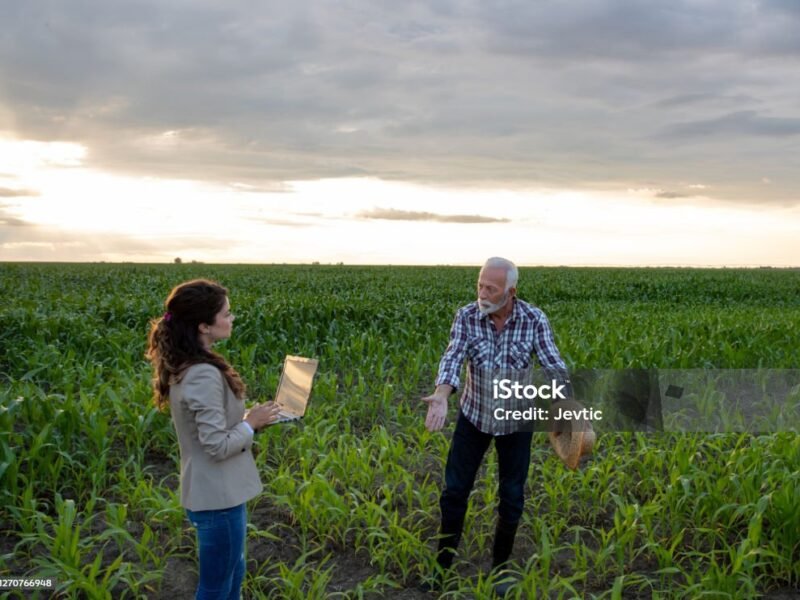THE IMPORTANCE OF CROP COVERAGE FOR FARMERS
As a farmer, your crops are not just plants in the ground; they are your livelihood. The success or failure of your harvest can have a significant impact on your financial well-being. That’s why it is crucial to have proper crop coverage in place to protect yourself against unforeseen events that could destroy your crops and leave you empty-handed.
Crop coverage provides farmers with a safety net. It ensures that even if disaster strikes, such as severe weather, pests, or disease, you will still have some financial support to recover from the losses. Without crop insurance, you would be left to bear the entire burden yourself, which could be devastating for your business.
When considering crop coverage, it is essential to understand the different types of insurance available and how they can benefit you as a farmer.
Understanding the Different Types of Crop Insurance
- Multiple Peril Crop Insurance (MPCI): MPCI is the most common type of crop insurance and covers yield losses due to natural disasters, such as drought, excessive moisture, hail, and wind. This type of insurance provides protection against a wide range of risks, ensuring that you are not solely reliant on a single factor for your income.
- Revenue Protection (RP): RP insurance is designed to protect farmers against a decline in crop revenue caused by a decrease in prices or yields. It takes into account both the yield and price fluctuations and offers a guarantee that your revenue will not fall below a certain level.
- Crop-Hail Insurance: Crop-hail insurance focuses specifically on hail damage to your crops. Hailstorms can cause significant harm to your crops, destroying them completely or reducing their quality. Crop-hail insurance provides coverage for this specific risk and can be purchased in addition to other types of crop insurance.
By understanding the different types of crop insurance available, you can choose the coverage that best suits your farm’s needs and protects you from potential risks.
Weatherproofing Your Farm with Insurance
Mother Nature can be unpredictable, and as a farmer, you are at her mercy. Severe weather events, such as hurricanes, floods, or droughts, can wreak havoc on your crops and leave you with devastating losses. Weatherproofing your farm with insurance is a must to ensure that you can recover from such events and continue your farming operations.
One of the most crucial aspects of weatherproofing is having comprehensive crop insurance coverage. This coverage should include protection against natural disasters, as well as other risks like pests, diseases, and even fire. By having the right insurance policies in place, you can offset the financial burden of crop damage and focus on rebuilding your farm.
Additionally, it is essential to regularly review and update your insurance coverage to account for any changes on your farm. If you have expanded your operations, added new crops, or invested in new equipment, make sure that your insurance policies reflect these changes. By doing so, you can ensure that your coverage is adequate and that you are not underinsured when disaster strikes.
Livestock Insurance: A Comprehensive Guide for Farmers
For farmers who raise livestock, protecting your animals is just as important as protecting your crops. Livestock insurance provides coverage for the loss of animals due to accidents, illness, or other unforeseen events. It ensures that you are financially protected if your livestock is injured, stolen, or dies.
There are different types of livestock insurance policies available, depending on the type of animals you raise and the specific risks you face. Some common types of livestock insurance include:
- Mortality Insurance: Mortality insurance covers the death of animals due to accidents, diseases, or natural causes. This type of insurance is essential to protect the investment you have made in your livestock.
- Theft Insurance: Theft insurance provides coverage in the event that your livestock is stolen. Livestock theft can have a significant financial impact on your farm, and having proper insurance can help offset the losses.
- Livestock Transit Insurance: If you transport your livestock for breeding, shows, or sales, livestock transit insurance can provide coverage for accidents or injuries that occur during transit.
Having livestock insurance not only protects your financial investment but also gives you peace of mind knowing that you have a safety net in case of unexpected events.
Harvesting Peace of Mind: Farm Insurance Essentials
As a farmer, your farm is not just a place of work; it is your home and your livelihood. Protecting your farm and everything on it should be a top priority. Farm insurance provides comprehensive coverage for your farm property, equipment, and structures.
Farm insurance typically includes:
- Farm Property Insurance: This coverage protects your farm buildings, equipment, and machinery from damages caused by fire, storms, vandalism, or theft. It ensures that you can replace or repair essential items in the event of a loss.
- Farm Liability Insurance: Liability insurance is crucial for any farm, as it provides protection in the event that someone is injured on your property or if your actions cause damage to someone else’s property. It covers medical expenses, legal fees, and damages that may arise from such incidents.
- Farm Vehicle Insurance: If you have vehicles used for farming, such as tractors or trucks, farm vehicle insurance provides coverage for accidents, theft, and damages. It ensures that you can continue your operations even if your vehicles are damaged or stolen.
By having comprehensive farm insurance coverage, you can harvest peace of mind, knowing that your farm and everything on it is protected.
Smart Agribusiness Risk Management Strategies
Running a successful agribusiness requires more than just hard work and dedication. It also requires careful risk management to protect your business from potential threats. Here are some smart agribusiness risk management strategies to consider:
- Diversification: Don’t put all your eggs in one basket. Diversify your crops and livestock to spread the risk. If one crop fails, you will have others to fall back on.
- Financial Planning: Proper financial planning is essential for any agribusiness. Make sure you have a budget in place, maintain good financial records, and have a contingency plan for unexpected expenses or losses.
- Emergency Preparedness: Be prepared for emergencies by having an emergency plan in place. This includes having backup generators, emergency supplies, and a plan for evacuating livestock if necessary.
- Continuing Education: Stay updated on the latest farming techniques, technologies, and market trends. This will help you adapt to changing conditions and make informed decisions for your agribusiness.
By implementing these risk management strategies, you can mitigate potential threats to your agribusiness and ensure its long-term success.
Choosing the Right Insurance Provider for Your Farm
Selecting the right insurance provider for your farm is crucial. Here are some factors to consider when choosing an insurance provider:
- Experience and Reputation: Look for an insurance provider with experience in agricultural insurance. Check their reputation and customer reviews to ensure they have a track record of providing excellent service.
- Coverage Options: Make sure the insurance provider offers the specific coverage you need for your farm. Consider both crop insurance and farm insurance options to ensure comprehensive coverage.
- Customer Support: A good insurance provider should have a dedicated customer support team that is easily accessible and responsive to your needs. Prompt claims processing and assistance are essential during times of crisis.
- Financial Stability: Choose an insurance provider with a strong financial standing. This ensures that they can fulfill their obligations and pay claims when necessary.
By carefully selecting the right insurance provider, you can have peace of mind knowing that your farm is protected by a reliable and trustworthy company.
Common Misconceptions About Crop Coverage
There are several common misconceptions about crop coverage that farmers should be aware of:
- “Crop insurance is too expensive”: While crop insurance does come at a cost, the benefits of having coverage far outweigh the expense. The financial protection it provides can save you from significant losses in the long run.
- “I don’t need crop insurance because I have savings”: Even if you have savings, relying solely on them to cover crop losses can be risky. Crop insurance provides a safety net that can help you recover quickly and continue your farming operations.
- “Crop insurance only covers yield losses”: While crop insurance does cover yield losses, it can also provide protection against other risks, such as price fluctuations, revenue declines, and damage caused by natural disasters.
- “I don’t need crop insurance because my farm has never had a significant loss before”: Past performance is not a guarantee of future results. Just because your farm has not experienced a significant loss in the past does not mean it won’t happen in the future. Crop insurance provides peace of mind and financial protection against unforeseen events.
Understanding these misconceptions can help farmers make informed decisions about crop coverage and ensure they have the necessary protection for their farms.
Tips for Filing Crop Insurance Claims
Filing crop insurance claims can be a complex process, but following these tips can help make it smoother:
- Document Everything: Keep detailed records of your crops, including planting dates, input costs, and yield estimates. This documentation will be essential when filing a claim.
- Report Losses Promptly: As soon as you notice a loss or damage to your crops, report it to your insurance provider. Prompt reporting ensures that your claim can be processed quickly and efficiently.
- Follow the Rules: Familiarize yourself with the specific rules and requirements of your crop insurance policy. Adhere to planting deadlines, reporting deadlines, and any other guidelines outlined in your policy.
- Work with Your Insurance Agent: Your insurance agent is there to help you. Consult with them throughout the claims process and ask any questions you may have. They can guide you through the necessary steps and ensure you submit a complete and accurate claim.
By following these tips, you can navigate the crop insurance claims process with ease and maximize your chances of receiving a fair settlement.
Conclusion: Protecting Your Livelihood with Crop Coverage
Farming is a profession filled with uncertainty and risks. However, with the right crop coverage in place, you can protect your livelihood and ensure the long-term success of your agricultural business. From understanding the different types of crop insurance to weatherproofing your farm and choosing the right insurance provider, there are various steps you can take to harvest peace of mind.
Remember, smart agribusiness risk management strategies are vital. By diversifying, planning financially, preparing for emergencies, and staying informed, you can mitigate potential threats and safeguard your farm’s future.
Don’t fall prey to common misconceptions about crop coverage. Instead, educate yourself and make an informed decision that aligns with your farm’s specific needs and circumstances.
Lastly, when filing crop insurance claims, be diligent in documenting losses, reporting promptly, following the rules, and working closely with your insurance agent.
Protecting your livelihood with crop coverage is not just about financial security; it is about cultivating peace of mind and ensuring the sustainability of your farm for generations to come.
CTA: Use Writesonic to Produce Conversion Optimized Farmers Insurance
When it comes to choosing the right insurance for your farm, the process can be overwhelming. That’s where Writesonic comes in. Our innovative AI-powered platform can help you generate conversion-optimized content for your farmers insurance needs. From compelling blog articles to persuasive product descriptions, Writesonic has you covered. Visit our website today and let us help you grow your agribusiness with confidence.






